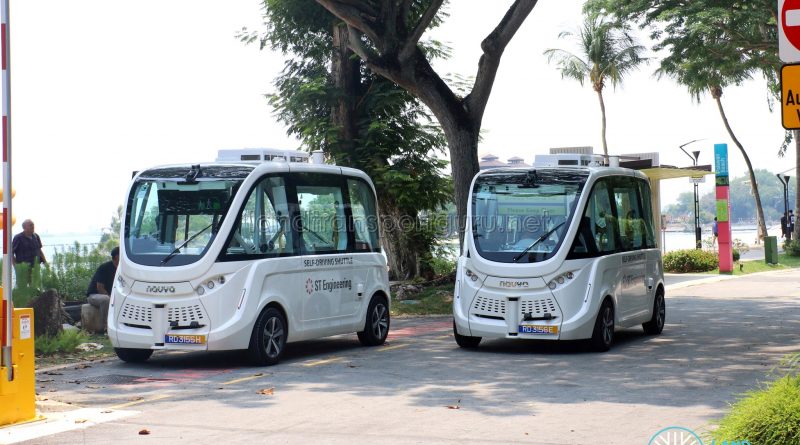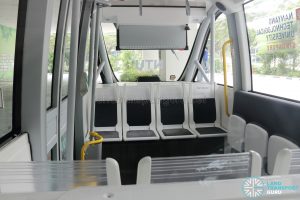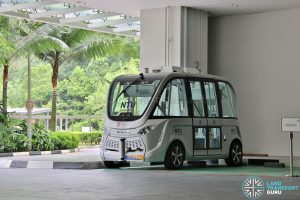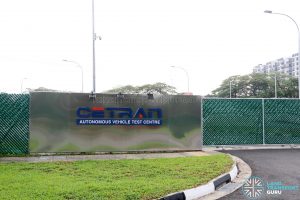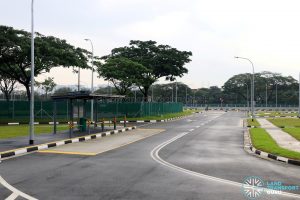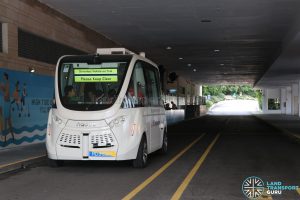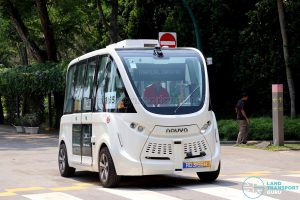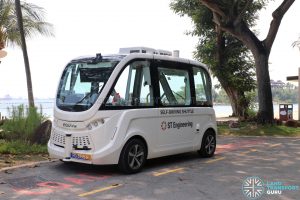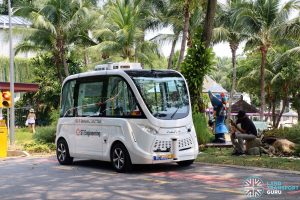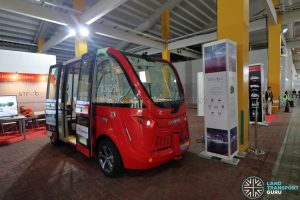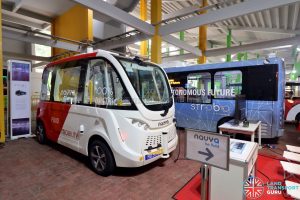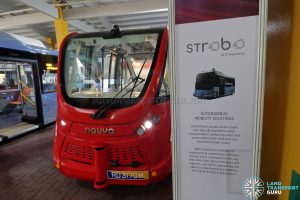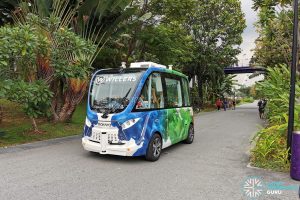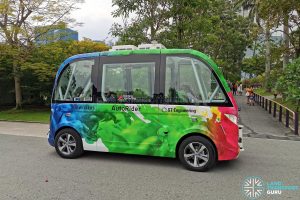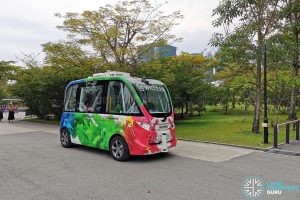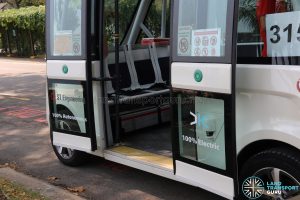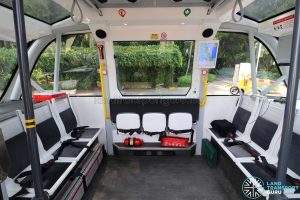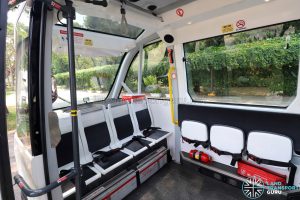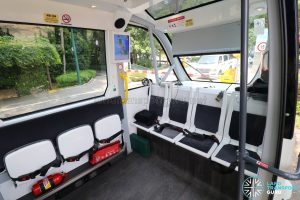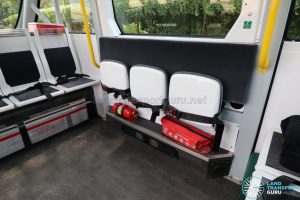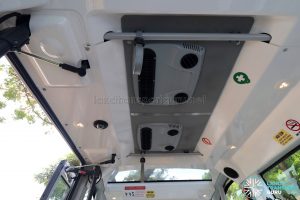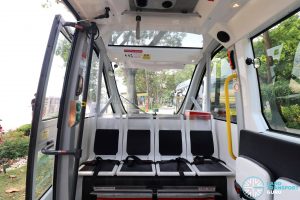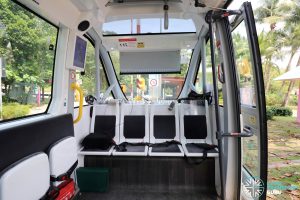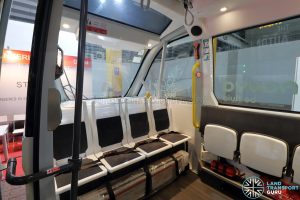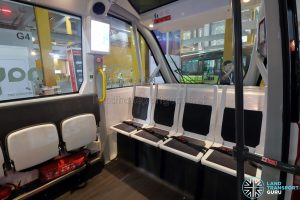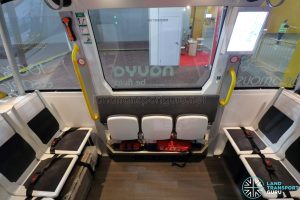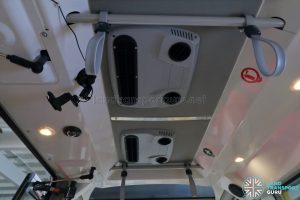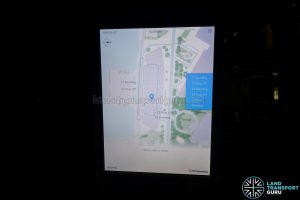| Navya Autonom Shuttle | |
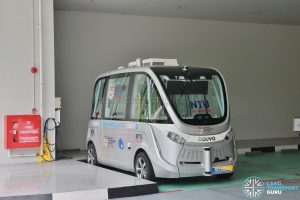 |
|
| Manufacturer | Navya |
| Years in operation | 2017 – |
| Operators | – Nanyang Technological University – ST Engineering Land Systems – Sentosa Development Corporation (Trial Basis) – Willers & CarClub (Gardens by the Bay Auto Rider) – Willers (Lakeside Garden shuttle) |
| Technical Data | |
| Length | 4.75 metre |
| Motor | TBC |
| Accessibility | Low Floor |
| Emission Standard | NA (Zero tailpipe emissions) |
The Navya Autonom Shuttle (previously known as Navya ARMA) is an autonomous, low-floor, battery-electric mini-bus built by Navya.
Since 2017, multiple units of the Navya Autonom Shuttle have been brought in to Singapore and are operating on various autonomous shuttle routes.
Background Information:
On 19 December 2016, Nanyang Technological University (NTU) signed a Memorium of Understanding (MOU) with NAVYA, sealing a two-year partnership for driverless technologies. The driverless electric minibus known as ARMA (later known as Autonom Shuttle) would run a loop between CleanTech Park and the university campus at up to 40kmh — twice the speed of earlier trials. It was the third driverless vehicle to be put on trial by the Energy Research Institute at NTU (ERI@N) then.
On 10 April 2017, ST Kinetics (STK) (now known as ST Engineering Land Systems) announced that it would develop four Mobility-on-Demand-Vehicles (MODVs) with Sentosa Development Corporation (SDC) and the Ministry of Transport (MOT). These vehicles are the ST Autobus and Navya Autonom Shuttle (2 units each).
Navya Autonom Shuttles have been deployed in cities around the world, with a notable presence in Europe, North America and Australia. In Asia, the Shuttles are deployed in Fukushima (Japan), Hong Kong and Singapore.
Autonomous Technologies:
- Global Navigation Satellite System (GNSS) Antenna
Communicates between the GPS sensor and a base station to determine the precise position of the vehicle at any moment. - Odometry
Measures the displacement and speed of each wheel to estimate the velocity of vehicle and change in vehicle position. - Cameras
Detect obstacles and estimate their position relative to the vehicle. Supplement perception maps with environmental analysis (road signs, traffic lights) and classification. - LIDAR (Light Radar) Sensors
Provide 2D & 3D perception maps of the environment to allow for precise vehicle positioning and obstacle detection.
Charging System:
Plug-in Charging System. A 90% charge takes about 9 hours using a 3.6 kW plug, or 4 hours with a 7.2 kW plug.
See Also: Autonomous Buses in Singapore
Navya Autonom Shuttle:
| Basic Technical Specifications | |
| Size | 4.75m (Length) x 2.11m (Width) x 2.65m (Height) |
| Weight | Curb Weight: 2,400kg | Maximum vehicle Weight: 3,450kg |
| Motor / Battery | Electric Motor (15kW nominal, 25kW peak) Lithium Iron Phosphate batteries (33 kWh) – Theoretical 9-hour battery life |
| Bodywork | Not Applicable (Integral bodywork) |
| Passenger Capacity | 11 Seating + 4 Standing = 15 total |
| Door | Single door, with double door wings |
| Maximum Operating Speed | Up to 25 km/h |
| Operating Range | Up to 30 km/charge depending on the operating scenario |
| Autonomous Technologies | Two 360° multi-layer LIDARs Six 180° single-layer LIDARs Front & Rear cameras Wheel encoders + Intertial sensor for Odometry Real-time kinematic (RTK) navigation using GNSS |
Autonomous Bus Trial in NTU:
The mini bus was tested on the roads between CleanTech Park and the NTU campus in early 2017, with the above unit registered as RD3131B.
Autonomous Bus Trial in CETRAN:
In November 2017, as part of the launch of The Centre of Excellence for Testing and Research of Autonomous Vehicles (CETRAN), a second unit of the Nayva Autonom Shuttle was launched in Singapore, for testing purposes on the newly built autonomous test circuit.
Autonomous Bus Trial in Sentosa:
Main Article: Autonomous Bus Trial in Sentosa
On 5 June 2018, in a joint press release with MOT, SDC, and STE, a three-month operational trial was announced for 2019, with commuters being able to hail the autonomous buses via their smartphones or at designated kiosks set up along the 5 km route on Sentosa Island. The 5 km route is believed to the be Sentosa Beach Tram route, plying from Beach Station to Siloso Point, Palawan Beach, and Tanjong Beach.
The trial was mentioned back in April 2017, as part of a partnership between Ministry of Transport and Sentosa Development Corporation for a two-year trial involving MODVs. Routes identified back then for the autonomous vehicles were between Tanjong Beach – Siloso Point, Palawan East – Siloso Point & Sentosa Golf Club – Imbiah Lookout.
From 5 June 2018, the autonomous shuttles were tested along a 1 km stretch of service road at Tanjong Beach to iron out their operational systems and safety protocols. The testing was progressively extended to a 2km route linking Palawan and Siloso beaches by the end of 2018. During the testing phase, the autonomous vehicles did not ferry commuters.
As part of the trial, ST Engineering Land Systems (formerly known as ST Kinetics) developed a platform agnostic fleet management system which will analyse passenger demand planning and optimise route management in ride sharing services.
The trial was launched on 20 August 2019, with the public trial period from 26 August 2019 to 15 November 2019.
The 2 units deployed for Sentosa Island are registered as RD3155H and RD3156E.
ST Engineering Land Systems
An additional unit was registered as RD3170M and exhibited during the ITS World Congress Singapore 2019 as part of the ST Engineering Land Systems’ Autonomous Mobility Solutions.
Gardens by the Bay Auto Rider
Main Article: Auto Rider @ Gardens by the Bay – Autonomous Shuttle Bus Service
The Navya Autonom Shuttle is also deployed as an autonomous shuttle bus service from 26 October 2019 within the Gardens by the Bay compound, ferrying passengers from Bayfront Plaza to the Flower Dome conservatory. It is operated jointly by WILLERS, the Singapore subsidiary of Japan’s largest private bus operator, and CarClub, Singapore’s largest car-sharing operator.
Singapore Armed Forces – Kranji Camp III & Paya Lebar Air Base Trial
The Singapore Army Facebook Page mentioned in a post on 16 February 2021 that an Autonomous Shuttle trial for a year was taking place in Kranji Camp III.
A trial of 4 units commenced in April 2021 at Kranji Camp III & Paya Lebar Air Base to transport supplies and servicemen through scheduled services along a fixed routing as well as on-demand at designated stops via a mobile app.
Jurong Lake Gardens
One unit of the Navya Autonom Shuttle (RD3170M) is deployed as part of a people mover system trial at Lakeside Garden, the western section of Jurong Lake Gardens for two years from 3 December 2020.
The vehicle plies a 1.2 km route shuttling between the Entrance Pavilion and Grassland, operating from 10am to 4pm on weekdays for free. Fares may be applied at a later date.
Interiors (Sentosa Trial):
The cabin interior features 11 seats: 8 permanent seats and 3 foldable seats. With 4 additional standees, the vehicle carries a maximum of 15 passengers.
Grab poles and handgrips are located around the bus. The 15” information touchscreen can be used in tandem with audio announcements (via speakers).
Safety equipment provided includes a fire extinguisher and a safety pack containing a first aid kit, reflective vest, and breakdown triangle. An emergency hammer and an emergency door unlock lever are provided inside the vehicle. Emergency stop buttons and an intercom system are also provided.
A manual wheelchair ramp is folded and stored underneath the seats.
Interiors (ITS World Congress 2019 Exhibition):
External Links & References:
- Navya Autonom Shuttle Brochure – Navya
- NTU testing new driverless mini bus – ChannelNewsAsia
- Driverless buses may hit S’pore roads from 2020 – Today Online
- Singapore Opens An Autonomous Vehicles Centre – Navya
- Sentosa testing autonomous shuttle; public trial to begin in 2019 – ChannelNewsAsia
- Shaping Future Mobility – Autonomous Mobility Solutions – ST Engineering
- SAF starts autonomous vehicle trials in Kranji Camp III, Paya Lebar Air Base – The Straits Times
- Launch of autonomous vehicle at Jurong Lake Garden – Willers
- Jurong Lake Gardens – NParks
Back to Autonomous Buses in Singapore
Back to Bus Models
